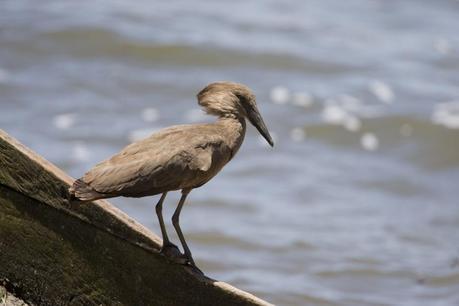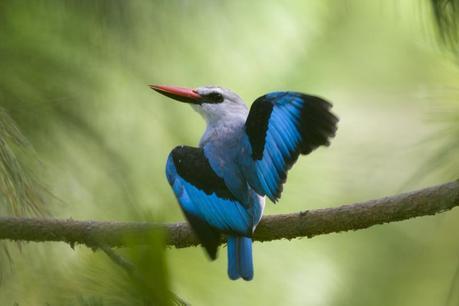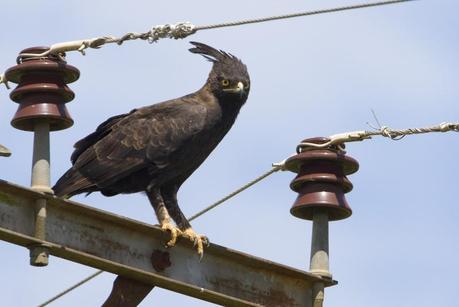The view from Long Crested Towers, Kampala
Kampala is a dusty, polluted city of 2 million inhabitants. The crowded industrial area slap bang in the centre of town, sits cheek by jowl with a slum of 100,000 people and a creaking and inadequate sewage system pours filth into nearby Lake Victoria. Drainage channels (for the country’s voluminous heavy rains) are the preferred waste disposal solution for many a Kampala household.
Originally on seven hills, the capital’s urban sprawl now covers at least three times that many hills now, the city’s population nurtured by rapid and increased urbanisation and the world’s 3rd highest birth rate.
But for all this, Kampala is still a birder’s dream with over 300 species. Forest birds, such as Black and White Casqued Hornbills, nest in a few remaining large trees in the city environs and Palmnut Vultures nest overlooking the golf course in the middle of the city.

Hammerkops often perch on the neighbour's roof. Here's one on the edge of Lake Victoria, just a few km away. Image Achilles Byaruhanga, Nature Uganda
I work in the centre of the capital and live in Bukasa, just 4 miles outside town – or less, as the Pied Crow flies. To many Kampalans, I may as well live in De Bush!
You can set your watch by the sound of the early morning birdsong in Uganda, more or less constant throughout the year, thanks to the country’s position on the Equator. The Woodland Kingfisher wakes me at 5.30 am sharp, very sharp; its shrill call forces my head off the pillow.
Great and Long Tailed Cormorants, Cattle and Little Egrets, Marabou Storks and Pink Backed Pelicans fly south towards the lake from their roosting site atop a statuesque hardwood Mvule tree in the middle of Kyangoga slum. They’re joined by the occasional Grey-Crowned Crane, Uganda’s most elegant national symbol. Usually seen in pairs, these Cranes mate for life, a commitment which, irony of all ironies, makes their eggs highly prized as wedding gifts – or so the urban myth goes. The Crane is further highly threatened due to destruction of its wetland habitat for conversion to farmland and agriculture (Uganda is a predominantly subsistence economy).
Iridescent Ruppell’s Starlings chuckle and scold from atop the water tank, swooping down to the garden tap to drink. Northern Grey-headed Sparrows pick at the crumbs left by the dogs and Red-billed firefinches bob in and out of the Bougainvillea. The hullaballo of a giant Eastern Grey Plantain Eater makes me look up as we pass under the electricity wire by the gate.
An early morning stroll with the dogs takes me along dusty marram roads towards Lake Victoria, a sea of Papyrus (and the inevitable construction sites) separating us from the men in dugout canoes fishing for Tilapia.
Kampala is a huge building site. Banana plantations and cassava plots metamorphose overnight. Over the past three years, we’ve frequently had to double back on ourselves when confronted by yet another new fence, a wall or a pile of freshly-baked red bricks.
And yet, turn a corner, and you’re back in the village, with ducks at your feet and a herd of cows slowly ambling past you.
The dogs scamper through the rough bush next to the house, inevitably picking up ticks left by grazing livestock. Cows are a status symbol in Uganda; the more you own, the greater respect you command. The dogs’ ticks can balloon to juicy fat currants before I notice them (where are the Oxpeckers when you need them?)
An African Open-Billed Stork, picking over the freshly hoed earth for snails, flies off at the sight of the dogs. A pair of Hadada Ibis cackle comically overhead – (no chance of a lie-in once these guys land on your roof).
A White-browed Coucal watches us from its perch on a termite mound.

The fabulous Woodland Kingfisher, Kampala - beautiful but noisy! Image Achilles Byaruhanga, Nature Uganda
Further down the track, en route to Port Bell fish landing site on Lake Victoria, we watch Hooded Vultures and Marabou Storks jostle for pickings amongst a big pile of fresh slaughtered pig heads at the open-air abattoir next to the railway track. The enormous Marabou Stork has a wing span of over two metres and is a frequent flier over Kampala. They can clean up faster than the City council: every day an estimated 10,000 of these scavengers (the largest known colony in the world) clean up 1-2 tons of the capital’s rubbish.
As the day warms up, we double back across the scrub, home to Long Crested Towers.*

A Long-Crested Eagle watched me from a telegraph post when I first viewed my new house - I took it as a lucky omen. Image Achilles Byaruhanga, Nature Uganda
A Long-Crested Eagle watched me from a telegraph post when I first viewed my new house; I took it as a good sign. No looking back – only up

*With a nod to Gerald Durrell.
For a list of the Birds of the Kampala area visit the Nature Uganda web site.
This post was originally written for David Lindo, the Urban Birder. He says “It’s estimated that by 2050 at least 75% of humankind will be living in cities. Many of us never leave our city environments. But within our sprawling cities there is birdlife to be found — sometimes in surprising abundance. If we open our eyes, look up and listen it will make itself known to us. What we have to do is learn how to appreciate the nature on our doorsteps and then we will fully understand the importance of worldwide conservation.”
David has a few Urban Birding tips to get you started:

